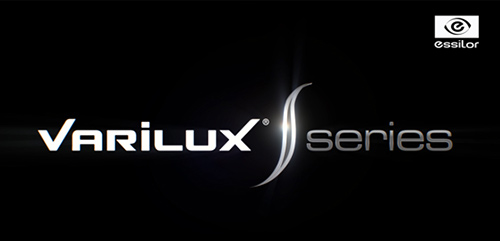A Powerful, Innovative Approach to Binocular Vision in Progressive Addition Lenses
Three groundbreaking technologies underlie the extraordinary benefits of new Varilux
S Series™ lenses:
- Nanoptix Technology™: A breakthrough technology that virtually eliminates “swim” compared to other premium progressive lenses. Nanoptix Technology™ reengineers the basic shape of the progressive lens by considering the lens as a set of many optical elements, allowing designers to minimize image deformation while maintaining the power progression.
- SynchronEyes Technology™: A powerful, innovative technology that integrates prescription data from both eyes into each lens, optimizing binocular visual fields and giving wearers expansive vision.
- 4D Technology™: A revolution in lens personalization that enhances overall visual response times by ensuring the sharpest vision in the leading dominant eye™. (Available only on Varilux S 4D™ lenses.) This paper will focus on SynchronEyes Technology™ and how, for the first time ever, a lens design technology is able to calculate left and right lenses simultaneously to achieve exceptional binocular vision.
Introduction


Up to now, technological limitations have made it impossible for progressive lenses to work with the eyes’ natural binocularity. Instead, it has been necessary to design and calculate progressive lenses as if each eye were a monocular system to be optimized without reference to the fellow eye. That changed with the advent of the revolutionary Varilux S Series™ lenses. With two groundbreaking new technologies—SynchronEyes™ and Nanoptix™—Varilux S Series™ lenses for the first time take advantage of our natural binocularity to create virtually unlimited fields of clear vision. Working together, SynchronEyes™ and Nanoptix™ technologies ensure that all Varilux S Series™ lenses offer clear binocular vision that virtually eliminates “swim” compared to other premium progressive lenses.
Binocular Vision
The neural processes that enable binocular vision take place in three stages. In the first stage, simultaneous foveal perception, light is turned into neural signals that are sent simultaneously from each retina to the brain’s visual cortex. Although the images are slightly different, the brain accepts both.
In the next stage, fusion, the visual cortex creates a single clear image from the two retinal images. For fusion to take place, the two images must be similar in size, shape, sharpness, brightness, and color. In the third step of binocular vision, stereopsis, the visual system builds a three-dimensional representation from the pair of two-dimensional retinal images.
Benefits of Binocularity
Binocular vision has three primary benefits: 1) stereopsis, 2) accurate perception of one’s position in space, and 3) binocular summation. Binocular summation requires good fusion and occurs when visual performance with both eyes is superior to visual performance with the best eye alone. This integration of information from each eye improves visual acuity, contrast sensitivity, and depth perception.
But what can enhance binocular summation? Jimenez and coworkers showed that binocular summation is best when the level of higher order aberration (HOA) is similar in both eyes.1 This was reinforced by Castro and coworkers, who demonstrated that binocular summation was greatest when the images in each eye were equal in terms of optical quality, as measured by the Strehl ratio of each eye.2 (The Strehl ratio, a widely recognized indicator of optical quality, is the ratio of a theoretical optimum point spread function to the measured point spread function.) Castro and coworkers found a statistically significant correlation between binocular summation and the Strehl ratio of each eye—that is, binocular summation was best when the Strehl ratio of one eye matched the Strehl ratio of the fellow eye (Figure 1).
 There are proven benefits to binocular summation. Jones and Lee showed that binocularly concordant information (which enables binocular summation) significantly enhances color and shape perception.3 Others have shown that binocular summation can significantly improve object detection and discrimination4-6.
There are proven benefits to binocular summation. Jones and Lee showed that binocularly concordant information (which enables binocular summation) significantly enhances color and shape perception.3 Others have shown that binocular summation can significantly improve object detection and discrimination4-6.
Taken together, these studies demonstrate that the greater the similarity between the two monocular images delivered to the brain, the better the quality of binocular summation. And the better the binocular summation, the better the acuity, contrast sensitivity, color and shape perception, and the ability to detect and discriminate between objects.
Managing Binocularity: Before Synchroneyes Technology™
In theory, then, optimizing binocular summation by delivering two images with equivalent levels of aberration to the brain ought to be a strategy for improving vision. Indeed, there have long been claims that various lenses supported binocular vision by managing left /right image imbalance in either of two ways.
The first of these is the location of visionzones to facilitate convergence. Distance, intermediate, and near zones have to be centered along the line on which the visual axis intersects the lens as the eye transitions from distance through intermediate to near vision. In particular, the center of the near vision zone has to be inset (shift ed nasally) with respect to the center of the distance zone. Positioning of the zones must take into account both the eye’s natural convergence and the lens’ prismatic eff ects, and the required inset is a function of monocular pupillary distance, vertex distance, reading distance, and prescription (distance power and add power).
A second, and now somewhat dated, strategy for supporting binocularity is the distribution of powers and aberrations across the lens, so that when gaze shift s off -axis the images in each eye are balanced with respect to optical quality.
A number of lenses have claimed to offer this “nasal/temporal balance.” Despite such claims, up to now all lens calculations have been based on monocular models that take into account, for a given eye, the rotational center, prescription, and perhaps some other parameters (eg, position of wear)—but for that eye only. Th e specifics of the other eye are never factored in. Monocular optimization can ensure good performance for each eye, but it cannot guarantee the balance between right and left retinal images.
Designing a progressive lens that optimizes binocular vision requires that the lenses enhance binocular summation; and this, in turn, requires the ability to ensure images of equivalent optical quality in each eye for each point of gaze.
Aberration Distribution


Sphere power is important in determining aberrations, but astigmatism correction has an even greater effect on the distribution of aberrations across a lens. Even keeping sphere, cylinder, and add powers constant, just changing the axis of astigmatism produces significant differences in the pattern of aberrations. When optical design is determined separately for each eye, it is virtually impossible to balance optical quality at each point of gaze because each lens has different power and aberration distributions.
With the appropriate soft ware, digital surfacing allows aberrations to be corrected monocularly, but without a way to coordinate the distribution of aberrations between lenses, the key condition for optimal binocular vision—equivalent levels of optical quality in both eyes at every direction of gaze—cannot be met.
Equivalent Image Quality at each gaze Point
As we have seen, unless the viewer is looking to “infi nity” through the center of each lens, there is no reason to assume that optical quality in the portions of each lens through which gaze is directed will be equivalent or even similar.


For binocular optimization, we need the ability to produce an image of equivalent optical quality at all homologous points on both lenses. And this is exactly what the SynchronEyes Technology™ does: it enhances binocularity by ensuring equivalent optical quality at all homologous points on both lenses. This can only be achieved with a means for mapping and comparing aberrations at homologous points, allowing both eyes to work together as one visual system.
The Cyclopean Eye
In SynchronEyes Technology™, the mapping of homologous points is accomplished by means of a theoretical model called the cyclopean eye, named for the mythical Greek Cyclops, who had a single eye in the middle of his forehead. In this model, the center of the cyclopean eye is the point midway between the eye rotation centers (ERCs) of the left and right eyes (Figure 4). By using the cyclopean eye, engineers can build a coordinate system in which the lens design for the left eye can be compared to and brought into conformity with that of the right eye. This ability to overlap and compare all homologous points on a pair of lenses is the basis of the revolutionary SynchronEyes™ design technology—technology that, for the first time, allows retinal image quality in one eye to be accurately coordinated with that of the fellow eye.
Using this unique, proprietary framework, Varilux S Series™ lenses are built in three steps (Figure 5):
- Step 1: The parameters of each eye are measured and recorded.
- Step 2: A binocular optical system is designed based on wearer parameters.
- Step 3: The binocular optical design is applied, with the right and left lenses optimized according to thetargeted binocular optical design.


Clinical Testing Validates Claims
Varilux. is committed to exhaustive testing of every new lens design before it is released. A critical element of this testing involves masked, prospective, randomized clinical trials with real patients.
In one such study, a group of 97 experienced progressive lens wearers compared Varilux S Series™ lenses to Varilux Physio Enhanced™ lenses, which are regarded by many as the best progressive lens design currently on the market.


Strong Preference for Varilux S Series™
Subjects rated their lenses on a 20-point scale. A look at the spider graph in Figure 6 shows that these wearers rated the Varilux S Series™ lenses higher on every parameter, including distance, near, and intermediate vision, dynamic vision, adaptation, and overall vision. To judge the effect of SynchronEyes Technology™, a new variable was created: “quality and width of vision.” To assess this variable, subjects were asked to separately rate (on the 20-point scale) their distance, intermediate, and near vision.


They were also asked to rate for each distance the width of the field of clear vision. Figure 7 shows the results of the two questions (which have been averaged to create the new single variable: quality and width of vision). Varilux S Series™ lenses outperformed Varilux Physio Enhanced™ lenses, demonstrating that with SynchronEyes Technology™, Varilux S Series™ lenses are able to provide wider fields of clear vision at every distance.
Conclusion
Binocular vision enables us to see better with both eyes than with either eye alone, but until the advent of SychronEyes Technology™, progressive lenses could not be designed to optimize binocularity. Because binocular vision is optimized—providing a maximally enlarged area of sharp, clear vision—when the retinal images in each eye are similar, SynchronEyes Technology™ coordinates the design of the left and right lenses to ensure that, wherever the viewer looks, the left and right lenses will provide similar quality images. The result is optimized binocularity, allowing both eyes to function as one visual system.
SynchronEyes™ and Nanoptix™, two breakthrough technologies, are combined in Varilux S Series™ lenses to produce the most stable, expansive vision ever in a progressive lens.
Nanoptix Technology™: A Breakthrough Technology Virtually Eliminates “Swim”
By design, the power of a progressive lens increases at a continuous, controlled rate from the distance to the near portion of the lens, to provide the presbyopic wearer with clear vision at all viewing distances. But this continuous change in power induces distortion in the lower part of the lens, which the wearer perceives as image deformation.
In static conditions, when neither the wearer nor the object of regard is moving, straight lines seen through the lower part of the lens will appear slightly curved, with the curvature increasing as lens power increases from the distance to the near portion of the lens. This is due to increasing prismatic deviation generated by the increasing power of the progressive curve.
In dynamic binocular vision, when either the wearer is in motion and/or objects in view are moving, this effect is amplified, and the wearer may experience the “swim effect”—which in extreme cases can induce motion sickness—because the objects are perceived to be moving unnaturally with respect to their environment. In the past, this phenomenon has affected all progressive lenses because, in the standard progressive lens, the base curve and the power increase continuously from the upper to the lower portions of the lens.
The “swim effect” is linked to the change in prismatic deviation as power increases from top to bottom of the lens. This can be quantified: The difference in horizontal displacement of a vertical line seen through a point near the top of the lens and the same line seen through a point lower on the lens is a value called Δx. Δx is a function of the difference in power and the shape of the lens. Dividing Δx by the maximum power variation ΔP, gives us a value, Δd, that we can use as an objective measure of “swim.”
Called the “end-to-end normalized deformation,” the closer this value is to zero—as it would be in a single vision lens—the less “swim” a lens will create. With Nanoptix Technology™, instead of considering the lens as single continuous curve, each lens is calculated as if it was made up of thousands of optical elements. The length and position of each element can be controlled in order to meet the precise requirements of the design and the power, while also reducing the value of Δd, to create a lens with reduced “swim.”
Thus,with Nanoptix Technology™, the lens is built element by element, completely reengineering the fundamental shapeof the lens.
References: 1. Jiménez JR, Castro JJ, Jiménez R, Hita E. Interocular differences in higher-order aberrations on binocular visual performance. Optometry and Vision Science. 2008;85(3):174-9. 2. Castro JJ, Jiménez JR, Hita E, Ortiz C. Influence of interocular differences in the Strehl ratio on binocular summation. Ophthalmic Physiological Optics. 2009;29(3):370-4. 3. Jones RK, Lee DN. Why two eyes are better than one: the two views of binocular vision. Journal of Experimental Psychology: Human Perception and Performance. 1981;7:30-40. 4. Benjamin WJ, Borish IM. Borish’s Clinical Refraction. 2nd ed. Butterworth-Heinemann-Elsevier; 2006. 5. Daum KM, McCormack GL. Chapter 5 “Fusion and binocularity.” in Benjamin WJ, Borish IM. Borish’s Clinical Refraction. 2nd ed. Butterworth-Heinemann-Elsevier; 2006. 6. Ciuffreda KJ. “Why two eyes?” Journal of Behavioral Optometry. 2002;13(2):35-7.










